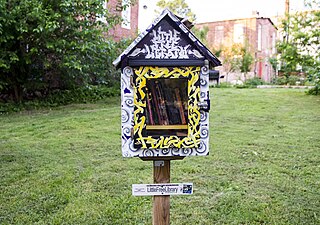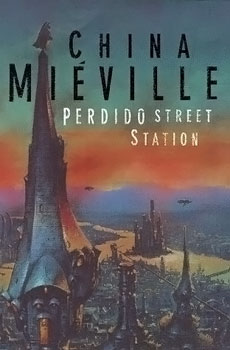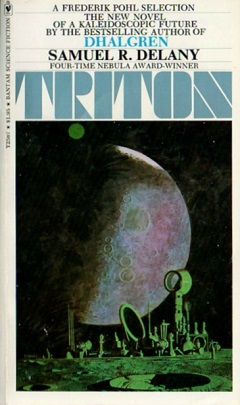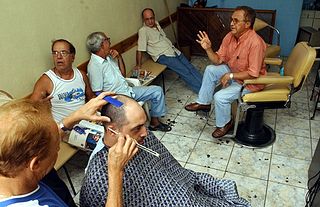The New Wave was a science fiction style of the 1960s and 1970s, characterized by a great degree of experimentation with the form and content of stories, greater imitation of the styles of non-science fiction literature, and an emphasis on the psychological and social sciences as opposed to the physical sciences. New Wave authors often considered themselves as part of the modernist tradition of fiction, and the New Wave was conceived as a deliberate change from the traditions of the science fiction characteristic of pulp magazines, which many of the writers involved considered irrelevant or unambitious.

Space is a three-dimensional continuum containing positions and directions. In classical physics, physical space is often conceived in three linear dimensions. Modern physicists usually consider it, with time, to be part of a boundless four-dimensional continuum known as spacetime. The concept of space is considered to be of fundamental importance to an understanding of the physical universe. However, disagreement continues between philosophers over whether it is itself an entity, a relationship between entities, or part of a conceptual framework.

The Dispossessed is a 1974 utopian science fiction novel by American writer Ursula K. Le Guin, one of her seven Hainish Cycle novels. It is one of a small number of books to win all three Hugo, Locus and Nebula Awards for Best Novel. It achieved a degree of literary recognition unusual for science fiction due to its exploration of themes such as anarchism and revolutionary societies, capitalism, utopia, individualism, and collectivism.
Utopian and dystopian fiction are subgenres of speculative fiction that explore social and political structures. Utopian fiction portrays a setting that agrees with the author's ethos, having various attributes of another reality intended to appeal to readers. Dystopian fiction offers the opposite: the portrayal of a setting that completely disagrees with the author's ethos. Some novels combine both genres, often as a metaphor for the different directions humanity can take depending on its choices, ending up with one of two possible futures. Both utopias and dystopias are commonly found in science fiction and other types of speculative fiction.

The sociology of knowledge is the study of the relationship between human thought, the social context within which it arises, and the effects that prevailing ideas have on societies. It is not a specialized area of sociology. Instead, it deals with broad fundamental questions about the extent and limits of social influences on individuals' lives and the social-cultural basis of our knowledge about the world. The sociology of knowledge has a subclass and a complement. Its subclass is sociology of scientific knowledge. Its complement is the sociology of ignorance.

Perdido Street Station is a novel by British writer China Miéville, published in 2000 by Macmillan. Often described as weird fiction, it is set in a world where both magic and steampunk technology exist. It won the Arthur C. Clarke Award and was ranked by Locus as the 6th all-time best fantasy novel published in the 20th century.

Trouble on Triton: An Ambiguous Heterotopia (1976) is a science fiction novel by American writer Samuel R. Delany. It was nominated for the 1976 Nebula Award for Best Novel, and was shortlisted for a retrospective James Tiptree, Jr. Award in 1995. It was originally published under the shorter title Triton.

Stars in My Pocket Like Grains of Sand (1984) is a science fiction novel by Samuel R. Delany. It is part of what would have been a "diptych", in Delany's description, of which the second half, The Splendor and Misery of Bodies, of Cities, remains unfinished.

In social theory and philosophy, antihumanism or anti-humanism is a theory that is critical of traditional humanism, traditional ideas about humanity and the human condition. Central to antihumanism is the view that philosophical anthropology and its concepts of "human nature", "man" or "humanity" should be rejected as historically relative, ideological or metaphysical.

The Maison d'Ailleurs is a museum of science fiction, utopia and extraordinary journeys in Yverdon-les-Bains (Switzerland). It is a non-profit foundation functioning both as a public museum and a specialized research center.

Neptune has appeared in fiction since shortly after its 1846 discovery, albeit infrequently. It initially made appearances indirectly—e.g. through its inhabitants—rather than as a setting. The earliest stories set on Neptune itself portrayed it as a rocky planet rather than as having its actual gaseous composition; later works rectified this error. Extraterrestrial life on Neptune is uncommon in fiction, though the exceptions have ranged from humanoids to gaseous lifeforms. Neptune's largest moon Triton has also appeared in fiction, especially in the late 20th century onwards.

Edward William Soja was an urbanist, a postmodern political geographer and urban theorist. He worked on socio-spatial dialectic and spatial justice.

In sociology, the third place refers to the social surroundings that are separate from the two usual social environments of home and the workplace. Examples of third places include churches, cafes, bars, clubs, community centres, public libraries, gyms, bookstores, makerspaces, stoops, parks, theaters, and opera houses, among others. In his book The Great Good Place (1989), Ray Oldenburg argues that third places are important for civil society, democracy, civic engagement and establishing feelings of a sense of place. Before Oldenburg's death, at 90, in 2022, he asked Karen Christensen, with whom he had corresponded and collaborated for many years, to write a new version of The Great Good Place, as well as keeping the original edition available.
Michel Foucault (1926–1984) was a prominent twentieth-century French philosopher, who wrote prolifically. Many of his works were translated into English. Works from his later years remain unpublished.

The sociology of space is a sub-discipline of sociology that mostly borrows from theories developed within the discipline of geography, including the sub fields of human geography, economic geography, and feminist geography. The "sociology" of space examines the social and material constitution of spaces. It is concerned with understanding the social practices, institutional forces, and material complexity of how humans and spaces interact. The sociology of space is an inter-disciplinary area of study, drawing on various theoretical traditions including Marxism, postcolonialism, and Science and Technology Studies, and overlaps and encompasses theorists with various academic disciplines such as geography and architecture. Edward T. Hall developed the study of Proxemics which concentrates on the empirical analysis of space in psychology.
Geocriticism is a method of literary analysis and literary theory that incorporates the study of geographic space. The term designates a number of different critical practices. In France, Bertrand Westphal has elaborated the concept of géocritique in several works. In the United States, Robert Tally has argued for a geocriticism as a critical practice suited to the analysis of what he has termed "literary cartography".

Samuel R. "Chip" Delany is an American writer and literary critic. His work includes fiction, memoir, criticism, and essays on science fiction, literature, sexuality, and society. His fiction includes Babel-17, The Einstein Intersection ; Hogg, Nova, Dhalgren, the Return to Nevèrÿon series, and Through the Valley of the Nest of Spiders. His nonfiction includes Times Square Red, Times Square Blue, About Writing, and eight books of essays. He has won four Nebula awards and two Hugo Awards, and he was inducted into the Science Fiction and Fantasy Hall of Fame in 2002.
The Long Earth is a collaborative science fiction novel series by British authors Terry Pratchett and Stephen Baxter.

Public rhetoric refers to discourse both within a group of people and between groups, often centering on the process by which individual or group discourse seeks membership in the larger public discourse. Public rhetoric can also involve rhetoric being used within the general populace to foster social change and encourage agency on behalf of the participants of public rhetoric. The collective discourse between rhetoricians and the general populace is one representation of public rhetoric. A new discussion within the field of public rhetoric is digital space because the growing digital realm complicates the idea of private and public, as well as previously concrete definitions of discourse. Furthermore, scholars of public rhetoric often employ the language of tourism to examine how identity is negotiated between individuals and groups and how this negotiation impacts individuals and groups on a variety of levels, ranging from the local to the global.
Carl Howard Freedman is an American writer, literary theorist and professor of English literature at Louisiana State University. He is best known for the non-fiction book Critical Theory and Science Fiction, and his scholarly work on the writer Philip K. Dick. Freedman's other works include a series of books on Isaac Asimov, Ursula K. Le Guin and Samuel R. Delany, and several essays and a book on China Miéville. In 2018, he won the Pilgrim Award for lifetime contribution to science fiction and fantasy scholarship.















